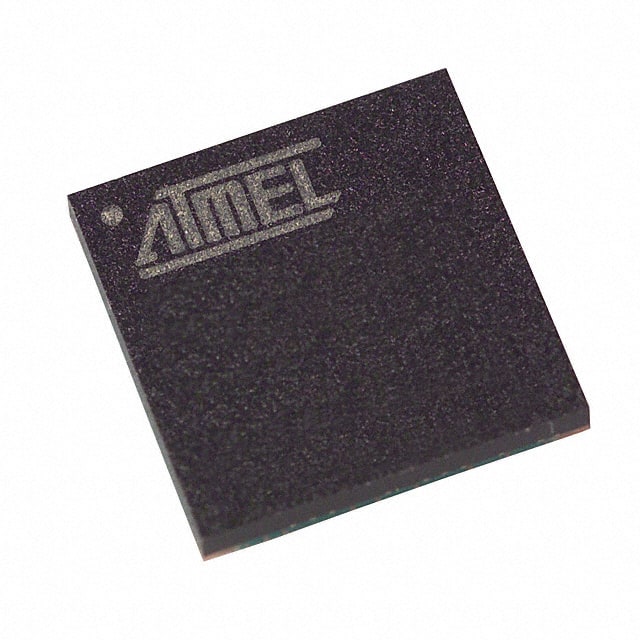AT89C51CC03C-7CTIM
Product Overview
Category
AT89C51CC03C-7CTIM belongs to the category of microcontrollers.
Use
It is commonly used in various electronic applications that require a microcontroller for processing and controlling functions.
Characteristics
- High-performance 8-bit microcontroller
- Low-power consumption
- Wide operating voltage range
- Integrated flash memory for program storage
- Multiple I/O ports for interfacing with external devices
- On-chip timers and counters for precise timing operations
Package
AT89C51CC03C-7CTIM is available in a compact and durable package, suitable for surface mount technology (SMT) applications.
Essence
The essence of AT89C51CC03C-7CTIM lies in its ability to provide efficient and reliable control and processing capabilities in electronic systems.
Packaging/Quantity
This microcontroller is typically packaged in reels or trays, with a standard quantity of 2500 units per reel/tray.
Specifications
- Architecture: 8-bit
- CPU Speed: 33 MHz
- Program Memory Size: 64 KB
- RAM Size: 2 KB
- Number of I/O Pins: 32
- Operating Voltage Range: 2.7V to 5.5V
- Operating Temperature Range: -40°C to +85°C
- Data Sheet: Link to Data Sheet
Detailed Pin Configuration
- VCC - Power supply voltage
- GND - Ground reference
- P0.0 - Port 0, Pin 0
- P0.1 - Port 0, Pin 1
- P0.2 - Port 0, Pin 2
- P0.3 - Port 0, Pin 3
- P0.4 - Port 0, Pin 4
- P0.5 - Port 0, Pin 5
- P0.6 - Port 0, Pin 6
- P0.7 - Port 0, Pin 7
- P1.0 - Port 1, Pin 0
- P1.1 - Port 1, Pin 1
- P1.2 - Port 1, Pin 2
- P1.3 - Port 1, Pin 3
- P1.4 - Port 1, Pin 4
- P1.5 - Port 1, Pin 5
- P1.6 - Port 1, Pin 6
- P1.7 - Port 1, Pin 7
- P2.0 - Port 2, Pin 0
- P2.1 - Port 2, Pin 1
- P2.2 - Port 2, Pin 2
- P2.3 - Port 2, Pin 3
- P2.4 - Port 2, Pin 4
- P2.5 - Port 2, Pin 5
- P2.6 - Port 2, Pin 6
- P2.7 - Port 2, Pin 7
- P3.0 - Port 3, Pin 0
- P3.1 - Port 3, Pin 1
- P3.2 - Port 3, Pin 2
- P3.3 - Port 3, Pin 3
- P3.4 - Port 3, Pin 4
- P3.5 - Port 3, Pin 5
Functional Features
- High-speed processing capabilities for efficient data handling
- On-chip flash memory allows easy program updates
- Multiple I/O ports enable seamless interfacing with external devices
- Integrated timers and counters for precise timing operations
- Low-power consumption for energy-efficient applications
- Wide operating voltage range ensures compatibility with various power sources
Advantages
- Reliable and robust performance in electronic systems
- Versatile functionality suitable for a wide range of applications
- Easy integration into existing designs due to standard pin configuration
- Efficient power management for extended battery life
- Cost-effective solution for microcontroller-based projects
Disadvantages
- Limited program memory size compared to some other microcontrollers
- Lack of advanced features found in higher-end microcontrollers
- May require additional external components for certain applications
Working Principles
AT89C51CC03C-7CTIM operates based on the principles of an 8-bit microcontroller architecture. It executes instructions stored in its flash memory, processes data from input devices, and controls
Senaraikan 10 soalan dan jawapan biasa yang berkaitan dengan aplikasi AT89C51CC03C-7CTIM dalam penyelesaian teknikal
Sure! Here are 10 common questions and answers related to the application of AT89C51CC03C-7CTIM in technical solutions:
Q: What is AT89C51CC03C-7CTIM? A: AT89C51CC03C-7CTIM is a microcontroller from the 8051 family, specifically designed for technical solutions requiring advanced control and communication capabilities.
Q: What are the key features of AT89C51CC03C-7CTIM? A: Some key features include a high-performance 8-bit CPU, multiple serial interfaces, on-chip flash memory, integrated timers/counters, and support for various communication protocols.
Q: What are the typical applications of AT89C51CC03C-7CTIM? A: AT89C51CC03C-7CTIM is commonly used in applications such as industrial automation, home automation, robotics, smart energy systems, IoT devices, and embedded control systems.
Q: How much flash memory does AT89C51CC03C-7CTIM have? A: AT89C51CC03C-7CTIM has 64KB of on-chip flash memory, which can be used for storing program code and data.
Q: Can I interface AT89C51CC03C-7CTIM with other devices? A: Yes, AT89C51CC03C-7CTIM supports multiple serial interfaces like UART, SPI, and I2C, allowing easy interfacing with other devices such as sensors, displays, and communication modules.
Q: Does AT89C51CC03C-7CTIM support real-time operating systems (RTOS)? A: Yes, AT89C51CC03C-7CTIM can be used with various RTOS implementations, enabling multitasking and efficient resource management in complex applications.
Q: What programming languages can be used to develop applications for AT89C51CC03C-7CTIM? A: AT89C51CC03C-7CTIM can be programmed using assembly language or high-level languages like C or C++, which offer more abstraction and ease of development.
Q: Can I update the firmware on AT89C51CC03C-7CTIM after deployment? A: Yes, AT89C51CC03C-7CTIM supports in-system programming (ISP), allowing you to update the firmware even after the microcontroller is soldered onto a PCB.
Q: Is AT89C51CC03C-7CTIM suitable for low-power applications? A: Yes, AT89C51CC03C-7CTIM offers power-saving features such as multiple sleep modes, clock gating, and wake-up interrupts, making it suitable for battery-powered or energy-efficient designs.
Q: Are there any development tools available for AT89C51CC03C-7CTIM? A: Yes, various development tools like integrated development environments (IDEs), compilers, debuggers, and programmers are available to aid in the development and testing of applications for AT89C51CC03C-7CTIM.
Please note that the specific details and answers may vary depending on the manufacturer's documentation and the context of the application.


